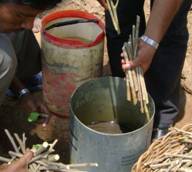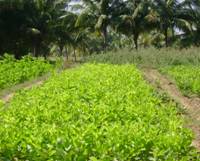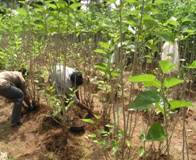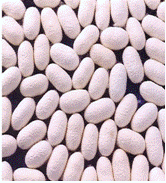Technologies Developed by TNAU Sericulture Department
1. Mulberry nursery technology
 |
 |
 |
Azospirillum treatment |
Mulching |
Mulberry saplings |
Soil management: Application of FYM @ 20 tones/ha or 12.5 tones of Composted coir pith and VAM @ 100 g/m2
Cuttings treatment: Dipping the cuttings in Azospirillum solution @1 kg in 40 litres of water for 30 minutes before planting
Weed management: Continuous mulching for 5 cm height (Critical period for weed competition is 45 days of planting)
Disease management: Soil application of Trichoderma viride and Pseudomonas fluorescens @ 2.5 kg each/ ha (Incubated with FYM at 1: 5 ratio for 15 days)
2. Integrated root rot management in mulberry
.jpg) |
.jpg) |
 |
Root rot affected mulberry garden |
Incubation of antagonistics |
Appliaction |
- Deep ploughing of land during summer
- Uprooting and burning of severely affected/ dead plants
- Soil drenching of affected plants and surroundings with 0.1 per cent carbendazim
- Application of oil cake @ 2 t/ ha/ yr and Zinc sulphate @ 10 kg/ ha in 2 split doses
- Application of biocontrol agents viz., Trichoderma viride, Bacillus subtilis and Pseudomonas fluorescens along with FYM (1:1:1:20) @ 100 g/ plant after incubation for 10 – 15 days.
3. IPM for mulberry leaf webber
- Irrigation of the mulberry field immediately after pruning to expose the leaf webber pupae.
- Release of pupal parasitoid, Tetrastichus howardii @ 50,000 / ha one day after pruning followed by release of egg parasitoid, Trichogramma chilonis @ 5 cc/ha at 10 days after pruning.
- Spraying of dichlorvos 76 WSC @ 1 ml / litre (500 ml/ha) on 30 days after pruning.
- Clipping and burning of the affected shoots.
4. Food supplementation for higher yield of cocoons
Soya flour supplementation twice @ 5g per kg of shoot immediately after third and fourth moult increased the cocoon yield by 7 kgs per 100 dfls.
5. “Ilamathi”, a phytojuvenoid for increasing the silk yield
.jpg) |
.jpg) |
 |
Ilamathi |
Feeding the treated leaves |
Good sized coccon |
Application of ‘Ilamathi’ (Phytojuvenoid) is safer to silkworms as it will not hinder the growth and development of larvae. The formulation increases the larval duration by about 14 hours. It has positive impact on economic parameters of silkworm like cocoon weight, shell weight and shell ratio.
Application method
- Treat the mulberry leaves with ‘Ilamathi’ @ 1ml/litre of water.
- Feed the second day of fifth instar larvae with treated leaves once in the morning.
Merits
- Gives an additional cocoon yield of 10 kg / 100 dfls.
- Possesses antiviral principles and hence reduces grasserie disease in silkworm.
6. IPM package for uzifly management
- Fixing nylon net fixed on doors and windows
- Application of uzicide @ 5 litres / 100 dfls on third, fourth and fifth instars.
- Releasing of hyperparasitoid, Nesolynx thymus @ one lakh adults / 100 dfls during fourth, fifth instar stage and after cocoon harvest.
- Installation of uzitrap using aziphor @ 25ml / litre and changed once in every three days from third instar stage onwards.
Further detail contact to
PROFESSOR AND HEAD
DEPARTMENT OF SERICULTURE
TAMIL NADU AGRICULTURAL UNIVERSITY
COIMBATORE – 641 003
TAMIL NADU, INDIA
Phone: Office: +91- 422 - 6611296
http://www.tnau.ac.in/cpps/seri/index.html |




.jpg)
.jpg)

.jpg)
.jpg)
